Labview中常用快捷键
LabVIEW的键盘快捷键
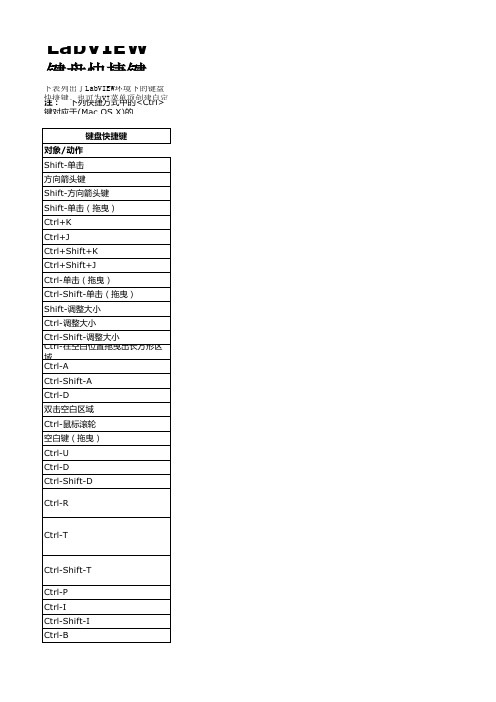
图
粘贴最近剪切或复制的对象。 显示即时帮助窗口。(Mac OS X) 按<Command-Shift-H>键。 锁定即时帮助窗口。 显示LabVIEW帮助。 切换到下一个最有用的工具。 切换至定位工具。 切换至滚动工具。 如自动工具选择被禁用,在两个最常用的工具间循环选择。 启用自动工具选择。 如通过单击自动工具选择按钮禁用了自动工具选择,则按<Tab>键可在最常用的四个工具中循环选择。 如通过 其它方式禁用了自动工具选择,则按<Tab>键将启用自动工具选择。 在临时的控件和函数选板上进行方向移动。 选择并进入一个临时选板。 跳出一个临时选板。 在光标处显示临时的工具选板。 显示子VI的前面板。 显示子VI的前面板和程序框图。 将该VI作为子VI放置在程序框图上。 将该VI作为子VI放置在程序框图上,并将没有默认值的输入控件与常量相连。 打开所选VI的前面板。 运行VI。 停止VI,在VI运行时使用。 切换至运行或编辑模式。 重新编译当前VI。 重新编译内存中的所有VI。 将选中光标移入数组或簇,在VI运行时使用。 将选中光标移出数组或簇,在VI运行时使用。 按Tab键顺序轮流选择控件,在VI运行时使用。 按Tab键反序选择控件,在VI运行时使用。 删除VI中的所有断线。如选择的结构或程序框图中有断线,该快捷方式仅删除选中区域的断线。 取消已开始的连线操作。 选中一个连线段。 选中一个连线分支。 选中整条连线。 连线时,暂停禁用自动连线路径选择。 连线时暂时停止另一端的连接,不连往另一个接线端。 将连线方向在水平和垂直方向之间切换。
Ctrl-V 帮助 Ctrl-H Ctrl-Shift-L Ctrl-?或<F1> 工具和选板 Ctrl Shift 在空白区域按<Ctrl-Shift> 空白键 Shift-Tab Tab 方向箭头键 Enter Esc Shift-右键单击 子VI 双击子VI Ctrl-双击子VI 拖曳VI图标至程序框图 Shift-拖曳VI图标至程序框图 Ctrl-右键单击程序框图并从选板 中选择VI 执行 Ctrl-R Ctrl-. Ctrl-M Ctrl-运行按钮 Ctrl-Shift-运行按钮 Ctrl-向下箭头 Ctrl-向上箭头 Tab Shift-Tab 连线 Ctrl-B Esc,右键单击或单击接线端 单击连线 双击连线 三击连线 A 双击 空白键
LabVIEW的键盘快捷键

搜索对象或文本。 打开搜索结果窗口或查找项目项对话框,其中显示上次搜索结果。 搜索VI中的下一个对象或文本。 搜索VI中的上一个VI、对象或文本。 根据窗口在屏幕上显示的顺序依次浏览LabVIEW窗口。(Linux) 窗口的顺序取决于窗口管理器。 按照相反的顺序浏览LabVIEW窗口。 显示错误列表窗口。 在项目浏览器窗口中显示当前VI。 显示全部窗口对话框。 打开类浏览器窗口。 显示前面板或程序框图。 显示快速放置对话框。在中文键盘上,按<Ctrl-Shift-Space>键。(Mac OS X) 按<Command-Shift-Space>键。 启用或禁用网格对齐。在法语键盘上,按<Ctrl-">键。(Mac OS X) 按<Command-*>键。 最大化窗口或还原窗口原始大小。 分左右或上下两栏显示前面板和程序框图。 显示导航窗口。 显示VI属性对话框。 显示历史窗口。 重新绘制VI层次结构窗口。 在VI层次结构窗口中显示所有VI。 显示在VI层次结构窗口中选中VI的子VI和其它构成该VI的节点。 在VI层次结构窗口中初始化一个搜索,输入文本,按回车键查找下一个匹配的节点。 在VI层次结构窗口中初始化一个搜索,输入文本,按<Shift-Enter>键查找上一个匹配的节点。 单步步入节点。 单步步过节点。 单步步出节点。 打开一个空VI。 打开一个现有VI。 关闭VI。 保存VI 保存所有打开的文件。 打印窗口。 退出LabVIEW。 撤消上次操作。 重做上次操作。 剪切选中对象。 复制选中对象。
LabVIEW键盘快捷键
下表列出了LabVIEW环境下的键盘快捷键。也可为VI菜单项创建自定义快捷方式。 注: 下列快捷方式中的<Ctrl>键对应于(Mac OS X)的<Option>或<Command>键,(Linux)的<Alt>键。 键盘快捷键 对象/动作 Shift-单击 方向箭头键 Shift-方向箭头键 Shift-单击(拖曳) Ctrl+K Ctrl+J Ctrl+Shift+K Ctrl+Shift+J Ctrl-单击(拖曳) Ctrl-Shift-单击(拖曳) Shift-调整大小 Ctrl-调整大小 Ctrl-Shift-调整大小 Ctrl-在空白位置拖曳出长方形区 域 Ctrl-A Ctrl-Shift-A Ctrl-D 双击空白区域 Ctrl-鼠标滚轮 空白键(拖曳) Ctrl-U Ctrl-D Ctrl-Shift-D Ctrl-R
Labview快捷键大全
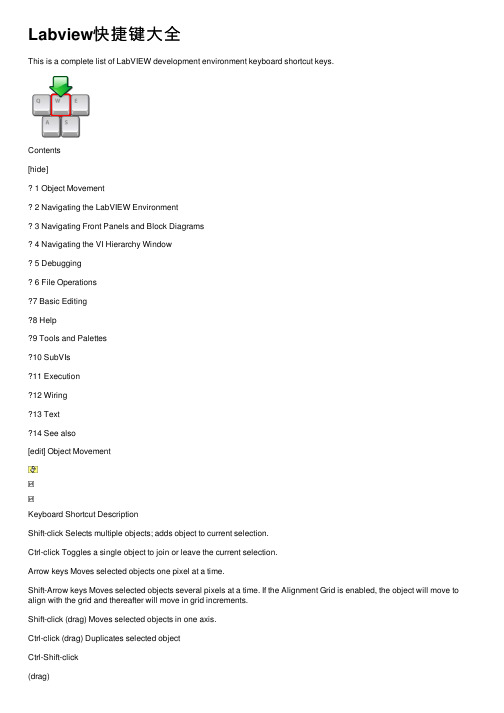
Labview快捷键⼤全This is a complete list of LabVIEW development environment keyboard shortcut keys.Contents[hide]1 Object Movement2 Navigating the LabVIEW Environment3 Navigating Front Panels and Block Diagrams4 Navigating the VI Hierarchy Window5 Debugging6 File Operations7 Basic Editing8 Help9 Tools and Palettes10 SubVIs11 Execution12 Wiring13 Text14 See also[edit] Object MovementKeyboard Shortcut DescriptionShift-click Selects multiple objects; adds object to current selection.Ctrl-click Toggles a single object to join or leave the current selection.Arrow keys Moves selected objects one pixel at a time.Shift-Arrow keys Moves selected objects several pixels at a time. If the Alignment Grid is enabled, the object will move to align with the grid and thereafter will move in grid increments.Shift-click (drag) Moves selected objects in one axis.Ctrl-click (drag) Duplicates selected objectCtrl-Shift-click(drag)Duplicates selected object and moves it in one axis.Shift-resize Resizes selected object while maintaining aspect ratio.Ctrl-resize Resizes selected object while maintaining center point.Ctrl-Shift-resize Resizes selected object while maintaining center point and aspect ratio. Ctrl-drag arectangleAdds more working space to the front panel or block diagram.Ctrl-A Selects all front panel or block diagram items.Ctrl-Shift-A Performs last alignment operation on objects.Ctrl-D Performs last distribution operation on objects.Double-click open space Adds a free label to the front panel or block diagram if automatic tool selection is enabled.Ctrl-mouse wheel Scrolls through subdiagrams of a Case, Event, or Stacked Sequence structure.g or G (no modifier keys) While dragging an object with the mouse, this momentarily toggles on or off the alignment grida or A (no modifier keys) While dragging an object on the block diagram, this momentarily toggles on or off the automatic wiringSpacebar (drag) Disables preset alignment positions when moving object labels or captions. [edit] Navigating the LabVIEW EnvironmentKeyboardShortcutDescriptionCtrl-F Finds objects or text.Ctrl-Shift-F Displays Search Results window or the Find Project Items dialog box with the previous search results.Ctrl-G Searches for next instance of object or text.Ctrl-Shift-G Searches for previous instance of VIs, object, or text.Ctrl-Tab Cycles through LabVIEW windows in the order the windows appear onscreen. The order of the windows depends on the window manager you use.Ctrl-Shift-Tab Cycles the opposite direction through LabVIEW windows. Ctrl-L Displays the Error List window.Ctrl-Shift-W Displays the All Windows dialog box.Ctrl-Shift-B Displays the Class Browser window.[edit] Navigating Front Panels and Block DiagramsKeyboardShortcutDescriptionCtrl-E Displays block diagram or front panel window.Ctrl-# Enables or disables grid alignment. On French keyboards, press the keys. (Mac OS) Press the keys.Ctrl-/ Maximizes and restores window.Ctrl-T Tiles front panel and block diagram windows.Ctrl-Shift-N Displays the Navigation window.Ctrl-I Displays the VI Properties dialog box.Ctrl-Y Displays the History window.[edit] Navigating the VI Hierarchy Window KeyboardShortcutDescriptionCtrl-D Redraws the VI Hierarchy window.Ctrl-A Shows all VIs in the VI Hierarchy window.Ctrl-click VI Displays the subVIs and other nodes that make up the VI you select in the VI Hierarchy window.Enter Finds the next node that matches the search string after initiating a search by typing in the VI Hierarchy window. Shift-Enter Finds the previous node that matches the search string after initiating a search by typing in the VI Hierarchy window.[edit] DebuggingKeyboard Shortcut DescriptionCtrl-Down arrow Steps into node.Ctrl-Right arrow Steps over node.Ctrl-Up arrow Steps out of node. [edit] File OperationsKeyboard Shortcut DescriptionCtrl-N Opens a new, blank VI.Ctrl-O Opens an existing VI.Ctrl-W Closes the VI.Ctrl-S Saves the VI.Ctrl-Shift-S Saves all open files.Ctrl-P Prints the window.Ctrl-Q Quits LabVIEW. [edit] Basic EditingKeyboard Shortcut DescriptionCtrl-Z Undoes last action.Ctrl-Shift-Z Redoes last action.Ctrl-X Cuts an object.Ctrl-C Copies an object.Ctrl-V Pastes an object. [edit] HelpKeyboard Shortcut DescriptionCtrl-H Displays Context Help window. Ctrl-Shift-L Locks Context Help window. Ctrl-? or Displays LabVIEW Help.[edit] Tools and PalettesKeyboard Shortcut DescriptionCtrl Switches to next most useful tool. Shift Switches to Positioning tool.Ctrl-Shift over openspaceSwitches to Scrolling tool.Spacebar Toggles between two most common tools if automatic tool selection is disabled.Shift-Tab Enables automatic tool selection.Tab Cycles through four most common tools if you disabled automatic tool selection by clicking the automatic tool selection button. Otherwise, enables automatic tool selection.Arrow keys Navigates temporary Controls and Functions palettes. Enter Navigates into a temporary palette.Esc Navigates out of a temporary palette.Shift-right-click Displays a temporary version of the Tools palette at the location of the cursor.[edit] SubVIsKeyboard Shortcut DescriptionDouble-click subVI Displays subVI front panel.Ctrl-double-click subVI Displays subVI block diagram and front panel. Drag VI icon to block diagram Places that VI as a subVI on the block diagram.Shift-drag VI icon to block diagram Places that VI as a subVI on the block diagram with constants wired for controls that have non-default values.Ctrl-right-click block diagram andselect VI from paletteOpens front panel of that VI. [edit] ExecutionKeyboard Shortcut DescriptionCtrl-R Runs the VI.Ctrl-. Stops the VI, when used while VI is running.Ctrl-M Changes to run or edit mode.Ctrl-Run button Recompiles the current VI.Ctrl-Shift-RunbuttonRecompiles all VIs in memory.Ctrl-Down arrow Moves key focus inside an array or cluster, when used while VI is running. Ctrl-Up arrow Moves key focus outside an array or cluster, when used while VI is running.Tab Navigates the controls or indicators according to tabbing order, when used while VI is running.Shift-Tab Navigates backward through the controls or indicators, when used while VI is running.[edit] WiringKeyboard Shortcut DescriptionCtrl-B Deletes all broken wires in a VI. Esc, right-click, or click terminal Cancels a wire you started. Single-click wire Selects one segment.Double-click wire Selects a branch.Triple-click wire Selects entire wire.A While wiring, disables automatic wire routing temporarily.Double-click (while wiring) Tacks down wire without connecting it. Spacebar Toggles automatic wiring while moving objects. Shift-click Undoes last point where you set a wire.Ctrl-click input on function with twoinputsSwitches the two input wires.Spacebar Switches the direction of a wire between horizontal and vertical.[edit] TextKeyboardShortcutDescriptionDouble-click Selects a single word in a string. Triple-click Selects an entire string.Ctrl-Right arrow Moves forward in string by one word when using text that has characters that use single bytes, such as Western character sets. Moves forward in string by one character when using text that has characters that use multiple bytes, such as Asian character sets.Ctrl-Left arrow Moves backward in string by one word when using text that has characters that use single bytes, such as Western character sets. Moves backward in string by one character when using text that has characters that use multiple bytes, such as Asian character sets.Home Moves to beginning of current line in string. End Moves to end of current line in string.Ctrl-Home Moves to beginning of entire string.Ctrl-End Moves to end of entire string.Shift-Enter Adds new items when entering items in enumerated type controls and constants, ring controls and constants, or Case structures. In string constants, press the keys on the keyboard to disable autosizing if it is enabled. If autosizing is disabled, press the keys on the keyboard to display a scroll bar in the constant.Esc Cancels current edit in a string.Ctrl-Enter Ends text entry.Ctrl-= Increases the current font size.Ctrl-- Decreases the current font size.Ctrl-0 Displays the Font dialog box.Ctrl-1 Changes to the Application font in Font dialog box. Ctrl-2 Changes to the System font in the Font dialog box. Ctrl-3 Changes to the Dialog font in the Font dialog box. Ctrl-4 Changes to the current font in the Font dialog box.。
labview中键选中函数实例教程

labview中键选中函数实例教程LabVIEW中键选中函数实例教程介绍•本教程将介绍LabVIEW中键选中函数实例的操作方法和技巧。
快捷键•LabVIEW提供了一些快捷键,方便用户快速选中函数实例。
•使用以下快捷键可以快速选中函数实例:–Ctrl + A:选中当前面板上所有的函数实例。
–Shift + 左键:按住Shift键并点击函数实例来逐个选中多个函数实例。
–Ctrl + Shift + 左键:按住Ctrl和Shift键,并点击函数实例来添加或取消选择指定的函数实例。
–Ctrl + Shift + A:取消选择所有选中的函数实例。
使用技巧•利用键选中函数实例,可以对这些函数实例进行批量操作,提高工作效率。
•如需对选中的函数实例进行操作,可以右击选中的函数实例,然后选择相应的操作菜单。
•在选中函数实例后,可以通过鼠标或键盘移动这些函数实例,方便重组和重新布局。
注意事项•在选中函数实例后,如果需要取消选择,请使用快捷键Ctrl + Shift + A。
•使用快捷键进行键选中函数实例时,请确保当前面板上没有其他选中的对象,否则可能会导致误选中其他对象。
以上就是LabVIEW中键选中函数实例的教程,希望能帮助你更好地应用LabVIEW进行编程和开发。
如果还有其他问题,请参考LabVIEW 帮助文档或在线社区寻求帮助。
更多技巧•在选中函数实例后,可以使用快捷键进行常用操作,比如复制、剪切、删除等。
例如:–Ctrl + C:复制选中的函数实例。
–Ctrl + X:剪切选中的函数实例。
–Delete:删除选中的函数实例。
•如果需要在不同的位置同时进行函数实例的选中和操作,可以使用多个面板。
选中一个面板上的函数实例后,再点击另一个面板即可将选中的函数实例添加到该面板上。
•选中的函数实例可以通过LabVIEW的拖拽功能来移动到其他面板中,方便进行布局调整和重组。
•在选中的函数实例上按下Ctrl键后,可以通过拖拽鼠标来进行复制操作。
LabVIEW常用快捷键

Ctrl+D
重新绘制VI层次窗口
Ctrl+A
显示所有VI
Ctrl+鼠标单击VI
显示该VI的所有子VI和其他节点
回车
跳至下一个符合关键词的字符串(开始搜索后有效)
Shift+回车
跳至上一个符合关键词的字符串(开始搜索后有效)
文本
鼠标双击
选中字符串中的一个词
鼠标三击
选中整个字符串
Ctrl+→
Shift
切换至定位(Positioning)工具
Ctrl+Shift
切换至滚动(Scrolling)工具
空格
在两个最常用工具间切换(在未使用自动选择工具下可用)
Shift+Tab
使用自动选择工具(在未使用自动选择工具下可用)
Tab
在四个最常用工具间切换(在未使用自动选择工具下可用)
↑↓←→
在面板上移动浏览焦点
Ctrl+-
减小当前字体大小
Ctrl+0
显示字体对话框
Ctrl+1
换至应用程序字体(Application Font)
Ctrl+2
换至系统字体(System Font)
Ctrl+3
换至对话框字体(Dialog Font)
Ctrl+4
换至当前字体(Current Font)
保持VI
Ctrl+P
打印当前窗口
Ctrl+Q
退出LabView
基本编辑
Ctrl+Z
撤销上一操作
Ctrl+Shift+Z
重执行上一操作
LabVIEW常用快捷键
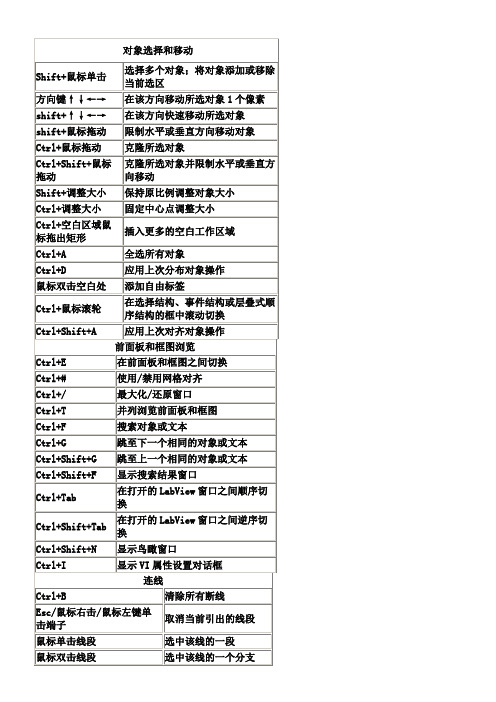
Ctrl+D
重新绘制VI层次窗口
Ctrl+A
显示所有VI
Ctrl+鼠标单击VI
显示该VI的所有子VI和其他节点
回车
跳至下一个符合关键词的字符串(开始搜索后有效)
Shift+回车
跳至上一个符合关键词的字符串(开始搜索后有效)
文本
鼠标双击
选中字符串中的一个词
鼠标三击
选中整个字符串
Ctrl+→
光标后移动一个词
Ctrl+←
光标向前移动一个词
Home
光标移动至当前行首
End
光标移到至当前行末
Ctrl+Home
光标移动至整个字符串首
Ctrl+End
光标移动至整个字符串尾
Shift+回车
编辑枚举型对象项目时插入新项
Esc
取消上一编辑文本操作
Ctrl+回车
确认编辑操作,跳出编辑状态
Ctrl+=
增大当前字体大小
Shift+调整大小
保持原比例调整对象大小
Ctrl+调整大小
固定中心点调整大小
Ctrl+空白区域鼠标拖出矩形
插入更多的空白工作区域
Ctrl+A
全选所有对象
Байду номын сангаасCtrl+D
应用上次分布对象操作
鼠标双击空白处
添加自由标签
Ctrl+鼠标滚轮
在选择结构、事件结构或层叠式顺序结构的框中滚动切换
Ctrl+Shift+A
选中该线的一个分支
鼠标三击线段
选中整条线
labview键盘快捷方式
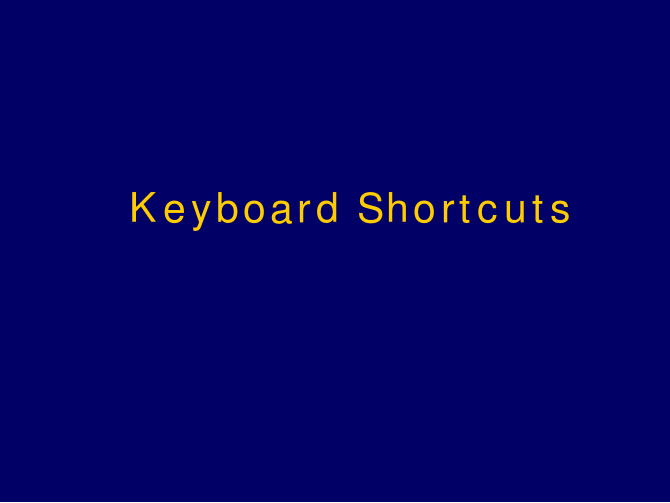
SubVIs
Keyboard Shortcut
Double-click subVI Ctrl-double-click subVI Drag VI icon to block diagram Shift-drag VI icon to block diagram Ctrl-right-click block diagram and select VI from palette
Help
Keyboard Shortcut Ctrl-H Ctrl-Shift-L Ctrl-? or <F1> Description Displays Context Help window. Locks Context Help window. Displays EW Help.
Basic Editing
Keyboard Shortcut Ctrl-Z Ctrl-Shift-Z Ctrl-X Ctrl-C Ctrl-V Description Undoes last action. Redoes last action. Cuts an object. Copies an object. Pastes an object.
Description
Displays subVI front panel. Displays subVI block diagram and front panel. Places that VI as a subVI on the block diagram. Places that VI as a subVI on the block diagram with constants wired for controls that have non-default values. Opens front panel of that VI.
LabVIEW_快捷键
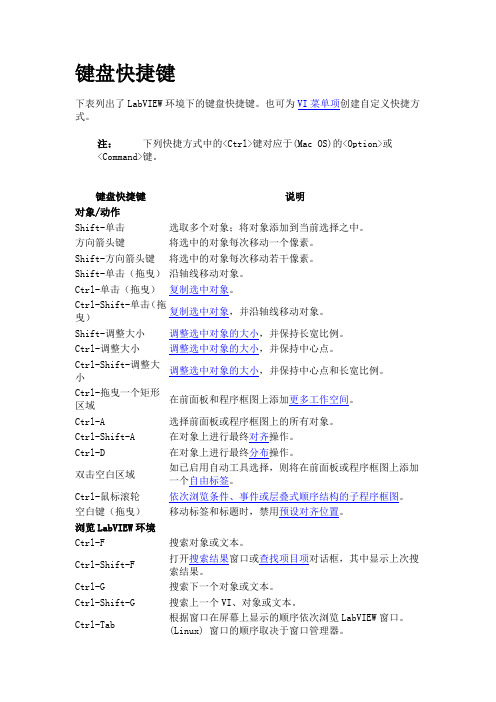
键盘快捷键下表列出了LabVIEW环境下的键盘快捷键。
也可为VI菜单项创建自定义快捷方式。
注:下列快捷方式中的<Ctrl>键对应于(Mac OS)的<Option>或<Command>键。
键盘快捷键说明对象/动作Shift-单击选取多个对象;将对象添加到当前选择之中。
方向箭头键将选中的对象每次移动一个像素。
Shift-方向箭头键将选中的对象每次移动若干像素。
Shift-单击(拖曳)沿轴线移动对象。
Ctrl-单击(拖曳)复制选中对象。
Ctrl-Shift-单击(拖曳)复制选中对象,并沿轴线移动对象。
Shift-调整大小调整选中对象的大小,并保持长宽比例。
Ctrl-调整大小调整选中对象的大小,并保持中心点。
Ctrl-Shift-调整大小调整选中对象的大小,并保持中心点和长宽比例。
Ctrl-拖曳一个矩形区域在前面板和程序框图上添加更多工作空间。
Ctrl-A 选择前面板或程序框图上的所有对象。
Ctrl-Shift-A 在对象上进行最终对齐操作。
Ctrl-D 在对象上进行最终分布操作。
双击空白区域如已启用自动工具选择,则将在前面板或程序框图上添加一个自由标签。
Ctrl-鼠标滚轮依次浏览条件、事件或层叠式顺序结构的子程序框图。
空白键(拖曳)移动标签和标题时,禁用预设对齐位置。
浏览LabVIEW环境Ctrl-F 搜索对象或文本。
Ctrl-Shift-F 打开搜索结果窗口或查找项目项对话框,其中显示上次搜索结果。
Ctrl-G 搜索下一个对象或文本。
Ctrl-Shift-G 搜索上一个VI、对象或文本。
Ctrl-Tab 根据窗口在屏幕上显示的顺序依次浏览LabVIEW窗口。
(Linux) 窗口的顺序取决于窗口管理器。
Ctrl-Shift-Tab 按照相反的顺序浏览LabVIEW窗口。
Ctrl-L 显示错误列表窗口。
Ctrl-Shift-W 显示全部窗口对话框。
浏览前面板和程序框图Ctrl-E 显示前面板或程序框图。
LabVIEW常用快捷键列表
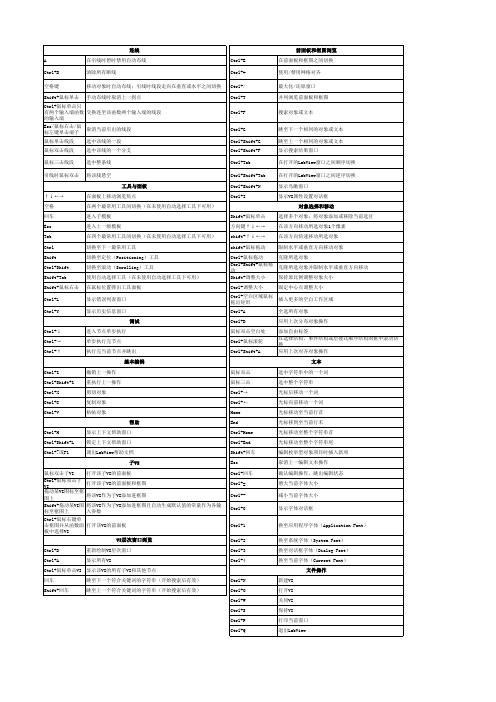
Ctrl+鼠标单击只 有两个输入端函数 交换连至该函数两个输入端的线段 的输入端 Esc/鼠标右击/鼠 取消当前引出的线段 标左键单击端子 鼠标单击线段 鼠标双击线段 鼠标三击线段 引线时鼠标双击 选中该线的一段 选中该线的一个分支 选中整条线 将该线悬空
Ctrl+鼠标单击VI 显示该VI的所有子VI和其他节点 回车 Shift+回车 跳至下一个符合关键词的字符串(开始搜索后有效) 跳至上一个符合关键词的字符串(开始搜索后有效)
前面板和框图浏览 在前面板和框图之间切换 使用/禁用网格对齐 最大化/还原窗口 并列浏览前面板和框图 搜索对象或或文本 显示搜索结果窗口 在打开的LabView窗口之间顺序切换 在打开的LabView窗口之间逆序切换 显示鸟瞰窗口 显示VI属性设置对话框 对象选择和移动 选择多个对象;将对象添加或移除当前选区 在该方向移动所选对象1个像素 在该方向快速移动所选对象 限制水平或垂直方向移动对象 克隆所选对象 克隆所选对象并限制水平或垂直方向移动 保持原比例调整对象大小 固定中心点调整大小 插入更多的空白工作区域 全选所有对象 应用上次分布对象操作 添加自由标签 在选择结构、事件结构或层叠式顺序结构的框中滚动切 换 应用上次对齐对象操作 文本 选中字符串中的一个词 选中整个字符串 光标后移动一个词 光标向前移动一个词 光标移动至当前行首 光标移到至当前行末 光标移动至整个字符串首 光标移动至整个字符串尾 编辑枚举型对象项目时插入新项 取消上一编辑文本操作 确认编辑操作,跳出编辑状态 增大当前字体大小 减小当前字体大小 显示字体对话框 换至应用程序字体(Application Font) 换至系统字体(System Font) 换至对话框字体(Dialog Font) 换至当前字体(Current Font) 文件操作 Ctrl+N Ctrl+O Ctrl+W Ctrl+S Ctrl+P Ctrl+Q 新建VI 打开VI 关闭VI 保持VI 打印当前窗口 退出LabView
LabView 快捷键大全
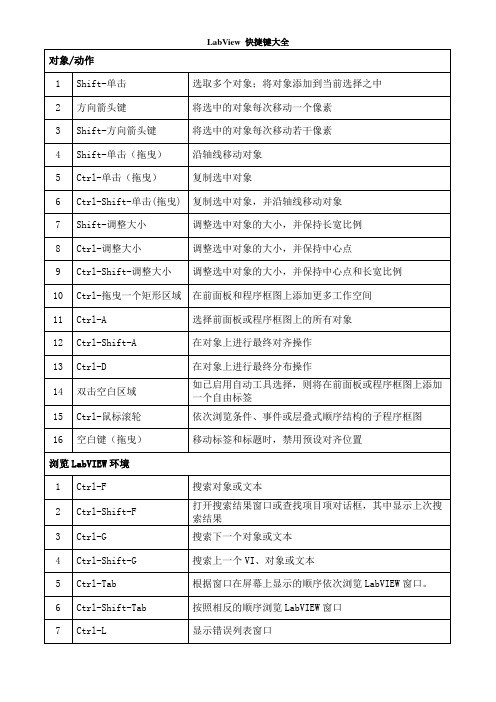
在对象上进行最终对齐操作
13
Ctrl-D
在对象上进行最终分布操作
14
双击空白区域
如已启用自动工具选择,则将在前面板或程序框图上添加一个自由标签
15
Ctrl-鼠标滚轮
依次浏览条件、事件或层叠式顺序结构的子程序框图
16
空白键(拖曳)
移动标签和标题时,禁用预设对齐位置
浏览LabVIEW环境
7
Shift-调整大小
调整选中对象的大小,并保持长宽比例
8
Ctrl-调整大小
调整选中对象的大小,并保持中心点
9
Ctrl-Shift-调整大小
调整选中对象的大小,并保持中心点和长宽比例
10
Ctrl-拖曳一个矩形区域
在前面板和程序框图上添加更多工作空间
11
Ctrl-A
选择前面板或程序框图上的所有对象
12
改变字体对话框中的当前字体
在光标处显示临时的工具选板
子VI
1
双击子VI
显示子VI的前面板
2
Ctrl-双击子VI
显示子VI的前面板和程序框图
3
拖曳VI图标至程序框图
将该VI作为子VI放置在程序框图上
4
Shift-拖曳VI图标至程序框图
将该VI作为子VI放置在程序框图上,并将没有默认值的输入控件与常量相连
5
Ctrl-右键单击程序框图并从选板中选择VI
8
Tab
按Tab键顺序轮流选择控件,在VI运行时使用
9
Shift-Tab
按Tab键反序选择控件,在VI运行时使用
连线
1
Ctrl-B
删除VI中的所有断线
Labview 快捷键大全
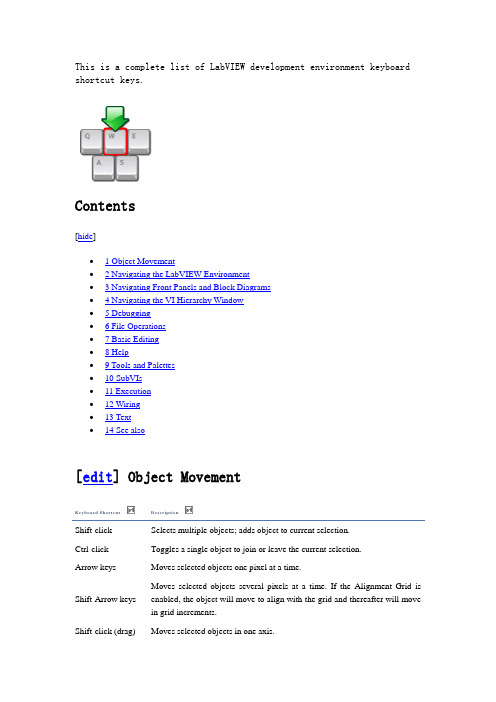
This is a complete list of LabVIEW development environment keyboard shortcut keys.Contents[hide]∙ 1 Object Movement∙ 2 Navigating the LabVIEW Environment∙ 3 Navigating Front Panels and Block Diagrams∙ 4 Navigating the VI Hierarchy Window∙ 5 Debugging∙ 6 File Operations∙7 Basic Editing∙8 Help∙9 Tools and Palettes∙10 SubVIs∙11 Execution∙12 Wiring∙13 Text∙14 See also[edit] Object MovementKeyboard Shortcut DescriptionShift-click Selects multiple objects; adds object to current selection.Ctrl-click Toggles a single object to join or leave the current selection.Arrow keys Moves selected objects one pixel at a time.Shift-Arrow keys Moves selected objects several pixels at a time. If the Alignment Grid is enabled, the object will move to align with the grid and thereafter will move in grid increments.Shift-click (drag) Moves selected objects in one axis.Ctrl-click (drag) Duplicates selected objectCtrl-Shift-click(drag)Duplicates selected object and moves it in one axis.Shift-resize Resizes selected object while maintaining aspect ratio.Ctrl-resize Resizes selected object while maintaining center point.Ctrl-Shift-resize Resizes selected object while maintaining center point and aspect ratio. Ctrl-drag arectangleAdds more working space to the front panel or block diagram.Ctrl-A Selects all front panel or block diagram items.Ctrl-Shift-A Performs last alignment operation on objects.Ctrl-D Performs last distribution operation on objects.Double-click open space Adds a free label to the front panel or block diagram if automatic tool selection is enabled.Ctrl-mouse wheel Scrolls through subdiagrams of a Case, Event, or Stacked Sequence structure.g or G (no modifier keys) While dragging an object with the mouse, this momentarily toggles on or off the alignment grida or A (no modifier keys) While dragging an object on the block diagram, this momentarily toggles on or off the automatic wiringSpacebar (drag) Disables preset alignment positions when moving object labels or captions. [edit] Navigating the LabVIEW EnvironmentKeyboardShortcutDescriptionCtrl-F Finds objects or text.Ctrl-Shift-F Displays Search Results window or the Find Project Items dialog box with the previous search results.Ctrl-G Searches for next instance of object or text.Ctrl-Shift-G Searches for previous instance of VIs, object, or text.Ctrl-Tab Cycles through LabVIEW windows in the order the windows appear onscreen. The order of the windows depends on the window manager you use.Ctrl-Shift-Tab Cycles the opposite direction through LabVIEW windows. Ctrl-L Displays the Error List window.Ctrl-Shift-W Displays the All Windows dialog box.Ctrl-Shift-B Displays the Class Browser window.[edit] Navigating Front Panels and Block DiagramsKeyboardShortcutDescriptionCtrl-E Displays block diagram or front panel window.Ctrl-# Enables or disables grid alignment. On French keyboards, press the <Ctrl-"> keys. (Mac OS) Press the <Command-*> keys.Ctrl-/ Maximizes and restores window.Ctrl-T Tiles front panel and block diagram windows.Ctrl-Shift-N Displays the Navigation window.Ctrl-I Displays the VI Properties dialog box.Ctrl-Y Displays the History window.[edit] Navigating the VI Hierarchy Window KeyboardShortcutDescriptionCtrl-D Redraws the VI Hierarchy window.Ctrl-A Shows all VIs in the VI Hierarchy window.Ctrl-click VI Displays the subVIs and other nodes that make up the VI you select in the VI Hierarchy window.Enter Finds the next node that matches the search string after initiating a search by typing in the VI Hierarchy window.Shift-Enter Finds the previous node that matches the search string after initiating a search by typing in the VI Hierarchy window.[edit] DebuggingKeyboard Shortcut DescriptionCtrl-Down arrow Steps into node.Ctrl-Right arrow Steps over node.Ctrl-Up arrow Steps out of node. [edit] File OperationsKeyboard Shortcut DescriptionCtrl-N Opens a new, blank VI.Ctrl-O Opens an existing VI.Ctrl-W Closes the VI.Ctrl-S Saves the VI.Ctrl-Shift-S Saves all open files.Ctrl-P Prints the window.Ctrl-Q Quits LabVIEW. [edit] Basic EditingKeyboard Shortcut DescriptionCtrl-Z Undoes last action.Ctrl-Shift-Z Redoes last action.Ctrl-X Cuts an object.Ctrl-C Copies an object.Ctrl-V Pastes an object. [edit] HelpKeyboard Shortcut DescriptionCtrl-H Displays Context Help window. Ctrl-Shift-L Locks Context Help window. Ctrl-? or <F1> Displays LabVIEW Help.[edit] Tools and PalettesKeyboard Shortcut DescriptionCtrl Switches to next most useful tool. Shift Switches to Positioning tool.Ctrl-Shift over openspaceSwitches to Scrolling tool.Spacebar Toggles between two most common tools if automatic tool selection is disabled.Shift-Tab Enables automatic tool selection.Tab Cycles through four most common tools if you disabled automatic tool selection by clicking the automatic tool selection button. Otherwise, enables automatic tool selection.Arrow keys Navigates temporary Controls and Functions palettes. Enter Navigates into a temporary palette.Esc Navigates out of a temporary palette.Shift-right-click Displays a temporary version of the Tools palette at the location of the cursor.[edit] SubVIsKeyboard Shortcut DescriptionDouble-click subVI Displays subVI front panel.Ctrl-double-click subVI Displays subVI block diagram and front panel. Drag VI icon to block diagram Places that VI as a subVI on the block diagram.Shift-drag VI icon to block diagram Places that VI as a subVI on the block diagram with constants wired for controls that have non-default values.Ctrl-right-click block diagram andselect VI from paletteOpens front panel of that VI. [edit] ExecutionKeyboard Shortcut DescriptionCtrl-R Runs the VI.Ctrl-. Stops the VI, when used while VI is running.Ctrl-M Changes to run or edit mode.Ctrl-Run button Recompiles the current VI.Ctrl-Shift-RunbuttonRecompiles all VIs in memory.Ctrl-Down arrow Moves key focus inside an array or cluster, when used while VI is running. Ctrl-Up arrow Moves key focus outside an array or cluster, when used while VI is running.Tab Navigates the controls or indicators according to tabbing order, when used while VI is running.Shift-Tab Navigates backward through the controls or indicators, when used while VI is running.[edit] WiringKeyboard Shortcut DescriptionCtrl-B Deletes all broken wires in a VI. Esc, right-click, or click terminal Cancels a wire you started. Single-click wire Selects one segment.Double-click wire Selects a branch.Triple-click wire Selects entire wire.A While wiring, disables automatic wire routing temporarily.Double-click (while wiring) Tacks down wire without connecting it. Spacebar Toggles automatic wiring while moving objects. Shift-click Undoes last point where you set a wire.Ctrl-click input on function with twoinputsSwitches the two input wires.Spacebar Switches the direction of a wire between horizontal and vertical.[edit] TextKeyboardShortcutDescriptionDouble-click Selects a single word in a string. Triple-click Selects an entire string.Ctrl-Right arrow Moves forward in string by one word when using text that has characters that use single bytes, such as Western character sets. Moves forward in string by one character when using text that has characters that use multiple bytes, such as Asian character sets.Ctrl-Left arrow Moves backward in string by one word when using text that has characters that use single bytes, such as Western character sets. Moves backward in string by one character when using text that has characters that use multiple bytes, such as Asian character sets.Home Moves to beginning of current line in string. End Moves to end of current line in string.Ctrl-Home Moves to beginning of entire string.Ctrl-End Moves to end of entire string.Shift-Enter Adds new items when entering items in enumerated type controls and constants, ring controls and constants, or Case structures. In string constants, press the <Shift-Enter> keys on the keyboard to disable autosizing if it is enabled. If autosizing is disabled, press the <Shift-Enter> keys on the keyboard to display a scroll bar in the constant.Esc Cancels current edit in a string.Ctrl-Enter Ends text entry.Ctrl-= Increases the current font size.Ctrl-- Decreases the current font size.Ctrl-0 Displays the Font dialog box.Ctrl-1 Changes to the Application font in Font dialog box. Ctrl-2 Changes to the System font in the Font dialog box. Ctrl-3 Changes to the Dialog font in the Font dialog box. Ctrl-4 Changes to the current font in the Font dialog box.。
LabVIEW软件中最常用的快捷键情况
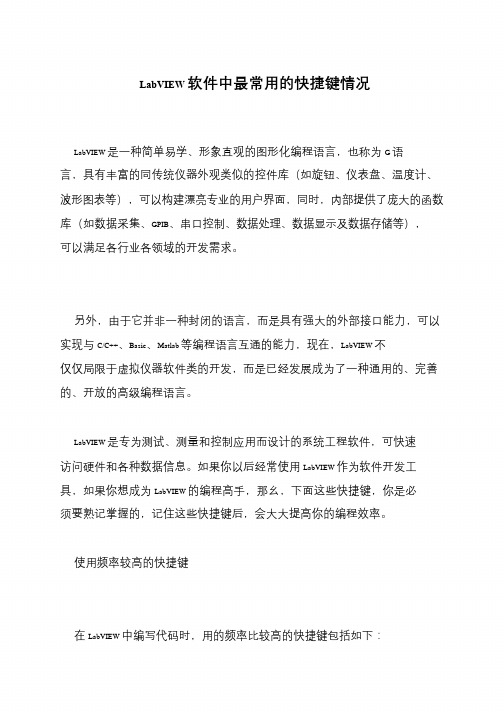
LabVIEW 软件中最常用的快捷键情况
LabVIEW 是一种简单易学、形象直观的图形化编程语言,也称为G 语言,具有丰富的同传统仪器外观类似的控件库(如旋钮、仪表盘、温度计、波形图表等),可以构建漂亮专业的用户界面,同时,内部提供了庞大的函数库(如数据采集、GPIB、串口控制、数据处理、数据显示及数据存储等),可以满足各行业各领域的开发需求。
另外,由于它并非一种封闭的语言,而是具有强大的外部接口能力,可以实现与C/C++、Basic、Matlab 等编程语言互通的能力,现在,LabVIEW 不仅仅局限于虚拟仪器软件类的开发,而是已经发展成为了一种通用的、完善的、开放的高级编程语言。
LabVIEW 是专为测试、测量和控制应用而设计的系统工程软件,可快速访问硬件和各种数据信息。
如果你以后经常使用LabVIEW 作为软件开发工具,如果你想成为LabVIEW 的编程高手,那幺,下面这些快捷键,你是必须要熟记掌握的,记住这些快捷键后,会大大提高你的编程效率。
使用频率较高的快捷键
在LabVIEW 中编写代码时,用的频率比较高的快捷键包括如下:。
LabVIEW进阶知识:想要成为编程高手,你不得不记住的快捷键

LabVIEW进阶知识:想要成为编程高手,你不得不记住的快捷键LabVIEW是一种简单易学、形象直观的图形化编程语言,也称为G语言,具有丰富的同传统仪器外观类似的控件库(如旋钮、仪表盘、温度计、波形图表等),可以构建漂亮专业的用户界面,同时,内部提供了庞大的函数库(如数据采集、GPIB、串口控制、数据处理、数据显示及数据存储等),可以满足各行业各领域的开发需求。
另外,由于它并非一种封闭的语言,而是具有强大的外部接口能力,可以实现与C/C++、Basic、Matlab等编程语言互通的能力,现在,LabVIEW不仅仅局限于虚拟仪器软件类的开发,而是已经发展成为了一种通用的、完善的、开放的高级编程语言。
LabVIEW是专为测试、测量和控制应用而设计的系统工程软件,可快速访问硬件和各种数据信息。
如果你以后经常使用LabVIEW作为软件开发工具,如果你想成为LabVIEW的编程高手,那么,下面这些快捷键,你是必须要熟记掌握的,记住这些快捷键后,会大大提高你的编程效率。
使用频率较高的快捷键在LabVIEW中编写代码时,用的频率比较高的快捷键包括如下:1. Ctrl + E:在前面板和框图程序之间相互切换,这应该是使用频率最高的一个快捷键2. Ctrl + H:显示或隐藏即时帮助窗口,写代码过程中遇到不会的函数时,通过它迅速查看函数定义及参数类型等3. Ctrl + R:运行程序,这个大家都知道4. Ctrl + .:停止程序运行5. Ctrl + B:删除断线,用的也比较多6. Ctrl + Z:撤销上步操作,用的非常多,当连错线、用错函数时,直接按这个键吧7. Ctrl + I:弹出设置VI属性对话框,在这里面修改VI的各种属性吧,如外观设置,窗口大小、位置设置等8. Ctrl + T:快速设置前面板和程序框图上下两栏显示9. Ctrl + /:使当前前面板或程序框图窗口在最大化/还原之间切换显示10. Ctrl + L:当程序不能运行时,迅速的按下它吧,看一下提示是哪儿出错了11. Ctrl + W:关闭当前窗口,当你打开的程序比较多时,不要点窗口右上角的叉了,按这个吧,倍快12. Ctrl + Q:退出LabVIEW编程环境其它通用快捷键与其它通用软件类似,通用的快捷键包括如下:1. Ctrl + N:新建VI程序2. Ctrl + S:保存VI程序3. Ctrl + O:打开程序4. Ctrl + F:弹出查找和替换对话框5. Ctrl + A:选择当前窗口上的全部控件对象或程序代码6. Ctrl + C:复制当前窗口上的全部控件对象或程序代码7. Ctrl + V:粘贴当前窗口上的全部控件对象或程序代码另外,还要记住的三大模板1. 控件模板:在前面板点击右键弹出,这是你程序中所有控件构建用户界面的来源2. 函数模板:在程序框图点击右键弹出,这是你程序中所有函数/代码的来源3. 工具模板:在前面板/程序框图按Shift键的同时再点击右键弹出,这是在前面板和程序面板上通用选项设置的来源,如设置窗口/控件的颜色等总结上面列出了LabVIEW软件中最常用的快捷键情况,这些快捷键不需要死记硬背,多用两次就自然而然的记住了,关键就是熟能生巧。
LABview
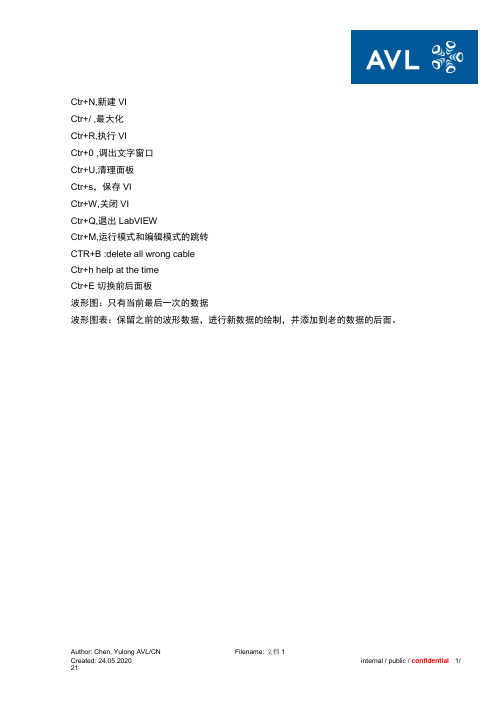
Ctr+N,新建VICtr+/ ,最大化Ctr+R,执行VICtr+0 ,调出文字窗口Ctr+U,清理面板Ctr+s,保存VICtr+W,关闭VICtr+Q,退出LabVIEWCtr+M,运行模式和编辑模式的跳转CTR+B :delete all wrong cableCtr+h help at the timeCtr+E 切换前后面板波形图:只有当前最后一次的数据波形图表:保留之前的波形数据,进行新数据的绘制,并添加到老的数据的后面。
数字型转字符串型点击运行后,可在后面板连接线上设置“探针”,点击连接线,右键→循环:1)For 循环计数:从0开始计数,0,1,2,3.....................2))利用两级循环创建数组显示,可以设置如第一级for 循环5次结束后,第二级循环开始计数1次,如此累计。
也叫嵌套。
3))for 循环,移位计算器使用时要初始化,,for 循环体的左边设置一个输入常量。
2)while 循环当你不知道什么循环几次时。
采用while 循环。
循环停止的条件:当输入条件为真时,循环停止;循环间隔(时间毫秒)3)顺序循环1))平铺式:从左往右运算2))层叠式:适合程序比较多,界面紧凑,采用“添加帧”来确定0,1,2,。
右键边框,选中添加顺序局部变量实现不同层下结果的处理。
4)条件结构下图为while 循环和条件循环的嵌套程序调试:1)查看/断点管理器2)设置探针,可以设置自定义探针在后面板点击连线,自定义探针---新建-- (探针显示控件必须与所要显示的信号同一类型!!!)5)事件结构如果要求事件结构运行,外围必须要有while循环!!!必须制定一个超时分支。
右键事件结构框,选择“编辑本事件分支” ,将“锁定前面板.....“勾掉!!!!!!添加事件停止分支:文件输入输出的基本概念数据的写入(excel, txt 等)1.自定义控件:用:信号处理/信号运算/自相关,来确定是否有周期性的信号存在,如下图1,即为有周期的信号经过自相关处理后结果。
labview快捷键大全

LabVIEW快捷键(全)对象调整和移动Shift-click 选择多个对象,在现有选择的基础上添加对象(方向键) 以一个像素为单位移动所选对象Shift- 以几个像素为单位移动所选对象Shift-click (拖动对象)在水平或垂直方向上移动对象Ctrl-click (拖动对象)复制所选对象Ctrl-Shift-click (拖动对象)复制所选对象并在水平或垂直方向上移动Shift-调整大小调整对象大小,并保持纵横比不变Ctrl-调整大小调整对象大小,并保持中心不变Ctrl-用鼠标拖曳出矩形在前面板或程序框图上扩大工作区空间Ctrl-A 选择前面板或程序框图上的所有对象Ctrl-Shift-A 执行上一次的“对齐对象”操作Ctrl-D 执行上一次的“分布对象”操作双击活动区空白处当打开“自动工具选择”时,将在前面板或程序框图上放置一个自由Ctrl-鼠标滑轮在Case, Event或Stacked Sequence structure中翻看各级子程序用键盘按键操作前面板/程序框图Ctrl-E 显示前面板或程序框图Ctrl-# 启动或关闭“对齐网格”功能。
Ctrl-/ 在法文键盘上,按<Ctrl-">键;Ctrl-T (Mac OS) 按住<Command->键。
Ctrl-F 最大化窗口或恢复窗口大小Ctrl-G 平铺前面板和程序框图窗口Ctrl-Shift-G 查找对象或文本Ctrl-Shift-F 查找对象或文本的下一个实例Ctrl-Tab 查找对象或文本的上一个实例Ctrl-Shift-Tab 显示Search Results窗口Ctrl-Shift-N 切换LabVIEW窗口Ctrl-I 反向切换LabVIEW窗口Ctrl-L 显示Navigation窗口Ctrl-Y 显示VI Properties对话框用键盘按键操作VI层次结构窗口Ctrl-D 刷新窗口Ctrl-A 显示窗口中所有VICtrl-单击VI 显示所选VI中的所有子VI和节点Enter 查找下一个符合搜索条件的节点Shift-Enter 查找上一个符合搜索条件的节点基本编辑操作Ctrl-Z 撤销上次操作Ctrl-Shift-Z 重复上次操作Ctrl-X 剪切对象Ctrl-C 复制对象Ctrl-V 粘贴对象文件操作Ctrl-N 新建VICtrl-O 打开现有VICtrl-W 关闭VICtrl-S 保存VICtrl-P 打印窗口Ctrl-Q 退出LabVIEW工具和选板Ctrl 转换到下一个常用工具Shift 转换到定位工具在活动区空白处按转换到滚动工具Ctrl-Shift空格键在最常用的两个工具间转换Shift-Tab 打开“自动工具选择”功能Tab 单击Automatic Tool Selection按钮关闭“自动工具选择”功能后,轮流选择最常用的四个工具。
LabVIEW快捷键

(方向键)
Shift- Shift- 单击 (拖曳) Ctrl- 单击 (拖曳) Ctrl-Shift- 单击 (拖曳) Shift- 调整大小 Ctrl- 调整大小 Ctrl-Shift- 调整大小 Ctrl- 在空白位置拖曳出长
方形区域
Ctrl-A Ctrl-Shift-A Ctrl-D
执行
Ctrl-R Ctrl-.† Ctrl-M Ctrl- 运行按钮 Ctrl-Shift- 运行按钮 Ctrl-† Ctrl-† Tab† Shift-Tab†
†
三击连线 运行 VI。 停止 VI。 切换至运行或编辑模式。 重新编译当前 VI。 重新编译内存中的所有 VI。 将键选中移入数组或簇。 将键选中移出数组或簇。 按照 Tab 键顺序轮流选中输入控件或显示 控件。 反向轮流选中输入控件或显示控件。 空白键
网络资源
选择帮助 » 网络资源,可访问 上的 LabVIEW 资源链接,包括软件升级、培训和研讨 会、客户解决方案、范例 VI、 LabVIEW 技术支持和说明文档、用户群、论坛等等。
LabVIEW
键盘快捷键
对象 / 动作
Shift- 单击
选取多个对象;将对象添加到当前 选择之中。 将选中的对象每次移动一个像素。 将选中的对象每次移动若干像素。 沿轴线移动对象。 复制选中对象。 复制选中对象,并沿轴线移动对象。 调整选中对象的大小,并保持长宽 比例。 调整选中对象的大小,并保持中心 点。 调整选中对象的大小,并保持中心 点和长宽比例。 在前面板和程序框图上添加更多工 作空间。 选择前面板或程序框图上的所有对 象。 在对象上进行最终对齐操作。 在对象上进行最终分布操作。 如已启用自动工具选择,则将在前 面板或程序框图上添加一个自由标 签。 依次浏览条件、事件或层叠式顺序 结构的子程序框图。 移动标签和标题时,禁用预设对齐 位置。 重新连线并重新排列程序框图对象。
LabVIEW常用快捷键(吐血整理)

LabVIEW常⽤快捷键(吐⾎整理)俗话说:主要采⽤⿏标操作的软件,它的极致是脱离⿏标,⾛向键盘;主要采⽤键盘操作的软件,它的极致是脚本⾃动化。
例如我们常⽤的Excel、Word、PS,它们的快捷键和脚本简直是逆天。
⼩⽩版快捷键Ctrl+E——切换前后⾯板(可以“⼯具栏”-“窗⼝”-“显⽰程序⾯板”⼿动操作)Ctrl+H——打开/关闭及时帮助(使⽤之后你就知道有多⽅便了,要不然不⽤的时候碍眼,⽤的时候点死你)Ctrl+B——清除断线(删改控件之后可能会出现很多断线,⼀键全删除)Ctrl+U——整理程序框图(虽然整理全部框图时效果往往不是很理想,但是整理局部时还是很有奇效的)Ctrl+N——新建VICtrl+S——保存VICtrl+R——运⾏VICtrl+T——左右两栏显⽰(类似于Windows⾥⾯的Windows键+⽅向键)Ctrl+/——最⼤化窗⼝Ctrl+⿏标拖动——克隆所选对象⿏标双击空⽩处——添加⾃由标签(草稿)什么复制粘贴、全选、撤回、打开⽂件这类快捷键与常⽤软件类似,不再赘述进阶版快捷键Ctrl+E——查找范例(范例中有很多你意想不到的惊喜╰(°▽°)╯进阶版的你必须⽤好范例)Ctrl+M——切换⾄运⾏/编辑模式(写程序时是编辑模式,切换⾄运⾏模式可以观看程序运⾏时的状态,适⽤于做界⾯设计时)Ctrl++/-——调整字体⼤⼩(⼿动选太难受了)Ctrl+Shift+K/J——将对象移⾄前⾯/后⾯(在调整前⾯板时会经常⽤到滴)Ctrl+Shift+N——导航窗⼝(程序⾯积太⼤时找不到⾃⼰要的部位,划拖动条太累?!试试这个)Ctrl+I——VI属性(这个⾥⾯是⼀个新天地,赶紧去看看,以后你会频繁地打开这个玩意⼉的)Ctrl+del——强制中断运⾏的VI(慎⽤,只有在退出机制⽆效时才⽤)结尾谨以此⽂献给落⼊Labview坑却仍不放弃的各位,我们不是专业的软件攻城狮,去有⼀颗上进谦逊的⼼。
- 1、下载文档前请自行甄别文档内容的完整性,平台不提供额外的编辑、内容补充、找答案等附加服务。
- 2、"仅部分预览"的文档,不可在线预览部分如存在完整性等问题,可反馈申请退款(可完整预览的文档不适用该条件!)。
- 3、如文档侵犯您的权益,请联系客服反馈,我们会尽快为您处理(人工客服工作时间:9:00-18:30)。
L a b v i e w中常用快捷键 This manuscript was revised by the office on December 22, 2012
C T R L+N新建C T R L+O打开C T R L+S保存CTRL+SHIFT+S全部保存CTRL+W关闭CTRL+P打印CTRL+IVI属性CTRL+U?整理程序框图
CTRL+拖动控件放大缩小控件CTRL+Z撤销前面的操作CTRL+X剪切CTRL+C复制CTRL+V粘贴CTRL+A全选CTRL+B删除断线CTRL+#启动前面板网格自动对齐CTRL+SHIFT+A对齐所选项CTRL+D分布所选项CTRL+VVI修订历史CTRL+F查找CTRL+SHIFT+F显示查找的结果CTRL+L错误列表CTRL+SHIFT+B类浏览器CTRL+SHIFT+N导航窗口CTRL+R运行VICTRL+.停止VICTRL+上单步步入CTRL+右单步步过CTRL+下单步步出(可以观察数据的流程)CTRL+M在运行和编辑界面间切换(切换到运行界面但不执行运行,变化不大)CTRL+E面板和程序框图间切换CTRL+T左右两栏显示窗口(面板和程序流诚一左一右)CTRL+/最大化窗口
CTRL+Q?退出Labview程序CTRL+H显示即时帮助(非常有用显示当前所选的器件的帮助资料)。
